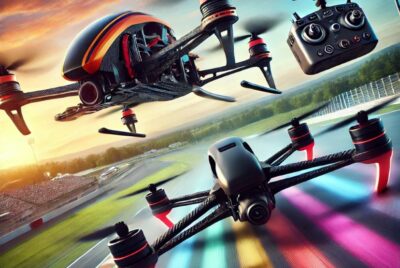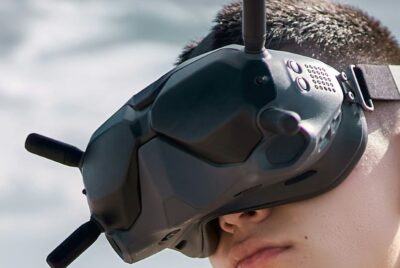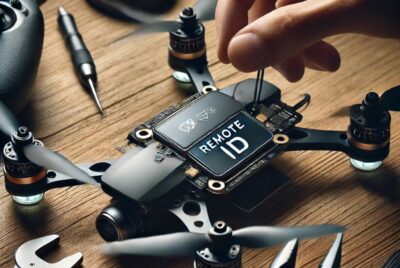FPV Drone Racing Laptops: The Best for Simulations and Editing
Hey there! Some links on this page are affiliate links which means that, if you choose to make a purchase, I may earn a small commission at no extra cost to you. I greatly appreciate your support! Please see our Disclosure to learn more.
Getting into FPV drone racing is one of the most exhilarating hobbies you can pick up. But whether you’re flying virtually or editing your race footage, having the right FPV drone racing laptop can make all the difference. As a fellow racer, I’ve spent countless hours tweaking my gear, testing out the latest tech, and perfecting my setups, so let’s dive into what makes a great FPV drone racing laptop for drone racing and editing, and explore some of the top picks for you.
Why You Need High-Performance FPV Drone Racing Laptops
The Demands of Simulation Software
If you’re just starting, simulators like Liftoff and Velocidrone are your best friends. They let you crash a hundred times without breaking a propeller, and trust me, we’ve all been there. But these simulators aren’t just games—they’re high-performance tools that demand serious power from your laptop. The smoother the graphics, the more realistic the flight experience, helping you build those muscle memories that make you a better pilot.
Editing Your Flight Footage
Once you start racing in the real world, capturing your flights on video is a must. Not only does it help you analyze your mistakes, but it also allows you to share your progress with others—something that really keeps the community spirit alive. Editing footage can be a resource-heavy task, and nothing’s worse than waiting for your laptop to catch up when you’re excited to post that killer clip.
I remember when I first started editing my videos on a clunky old laptop; it was so slow that by the time I finished a video, I could have done another race session! Upgrading to the right FPV drone racing laptop not only saved me time but made editing fun instead of frustrating.
Key Features of an FPV Drone Racing Laptop for Simulations and Editing
Graphics Card (GPU)
The GPU is the heart of your laptop when it comes to simulations. You’ll need something that can handle realistic graphics without lagging. A powerful GPU will render smoother visuals, helping you react to obstacles and perfect your maneuvers in the virtual world.
Processor (CPU)
The CPU is the brain that keeps everything running smoothly. For drone simulations and editing, a multi-core processor with high clock speeds will handle multiple tasks with ease, ensuring your laptop doesn’t slow down when you’re pushing it hard.
RAM
Aim for at least 16GB of RAM if you can. This allows your laptop to manage multiple processes simultaneously, such as running your simulation software, editing tools, and any background tasks without hitting a slowdown.
Storage (SSD vs. HDD)
Solid State Drives (SSDs) are a game-changer for speed. From faster boot times to quicker load screens in your simulators, SSDs offer a significant performance boost compared to traditional hard drives. Plus, your editing software will thank you.
Display Quality
A high-resolution display (1080p or better) makes a huge difference when you’re editing video. Colors are more vibrant, details are crisper, and the entire process feels more professional. If your budget allows, consider a laptop with a color-accurate display.
Portability vs. Performance
While the lure of a sleek, ultra-thin laptop is tempting, remember that performance is king in drone racing and editing. You’ll need to find a balance between something portable enough to carry to race meets and powerful enough to handle heavy loads.
Top FPV Drone Racing Laptops for Simulations
Here are some of the best laptops to consider for FPV simulations. Whether you’re on a tight budget or ready to invest, there’s something here for everyone.
Acer Nitro 5
The Acer Nitro 5 is a budget-friendly beast that packs a punch. With its NVIDIA GeForce GTX 1650 GPU and a 10th Gen Intel Core i5 processor, it handles most FPV simulators with ease. The 15.6-inch Full HD display is great for visuals, and the laptop’s cooling system keeps things smooth during long sessions.
I started with a laptop similar to this one, and it’s a fantastic entry point without breaking the bank. It’s not the lightest, but it makes up for it with reliable performance that’s perfect for beginners.
ASUS ROG Zephyrus G14
The ASUS ROG Zephyrus G14 is a powerful mid-range option. Its AMD Ryzen 9 processor and NVIDIA GeForce RTX 3060 GPU provide a silky smooth simulation experience. The 120Hz refresh rate screen ensures that every movement feels fluid, enhancing your training sessions.
I’ve used this laptop for editing too, and it’s a multitasking powerhouse. From simulation to video editing, it can handle everything you throw at it without breaking a sweat.
Dell G15 Gaming Laptop
The Dell G15 combines performance and durability, featuring an NVIDIA RTX 3050 GPU and an 11th Gen Intel Core i7 processor. With a robust build and excellent thermal management, this laptop is ideal for those long hours of practice. The 120Hz display offers an immersive simulation experience.
A friend of mine swears by this laptop for racing practice, and after trying it, I can see why. It’s perfect for those wanting a bit more power without stepping up to the highest price tier.
Razer Blade 15
The Razer Blade 15 is a premium choice, perfect for those who want the best. Featuring an NVIDIA RTX 3070 Ti GPU and a 12th Gen Intel Core i7 processor, it handles even the most demanding simulations with ease. The laptop’s sleek design and exceptional display make it a joy to use.
If you’re serious about your training and want a laptop that looks as good as it performs, the Razer Blade 15 is worth the investment. I’ve flown many simulated hours on this machine, and it’s an absolute dream.
MSI GE76 Raider
For those who crave top-tier performance, the MSI GE76 Raider is the way to go. Equipped with an NVIDIA RTX 3080 GPU and an Intel Core i9 processor, this laptop is a beast. The 17.3-inch display provides incredible visuals, and its advanced cooling system means it stays cool even under heavy loads.
This is the laptop you’ll want if you’re transitioning from simulations to professional-level practice. It’s an investment, but if you’re committed, it’s one that will pay off in faster lap times and smoother editing.
Best FPV Drone Racing Laptops for Video Editing
Let’s look at some laptops that excel in video editing, so you can cut your footage quickly and get back to flying.
Apple MacBook Pro (M1 Pro, 16-inch)
The MacBook Pro is a favorite among content creators, and for good reason. Its M1 Pro chip provides outstanding performance in video editing applications like Final Cut Pro and DaVinci Resolve. The 16-inch Retina display offers exceptional color accuracy, making your footage look its best.
As a PC guy who switched to the MacBook Pro for editing, I was blown away by how fast everything ran. It’s pricey, but for serious editing work, it’s hard to beat.
HP Envy x360
For those on a budget, the HP Envy x360 offers great editing capabilities without the premium price tag. It features AMD Ryzen 7 and Radeon graphics, making it suitable for handling most editing software. The convertible design is a bonus, offering versatility for creative work.
This was my go-to editing laptop for a while, and it’s a solid performer that punches above its weight.
Microsoft Surface Laptop 5
The Microsoft Surface Laptop 5 combines portability and power, featuring Intel’s 12th Gen Core i7 and a stunning PixelSense touchscreen display. It’s lightweight and easy to take to races, with enough power for on-the-go editing.
I love the Surface series for their portability; you can easily throw it in your backpack and have everything you need to edit right at your fingertips.
Lenovo Legion 5 Pro
The Lenovo Legion 5 Pro is another solid choice for video editing, thanks to its NVIDIA RTX 3060 GPU and AMD Ryzen 7 processor. It offers excellent performance for its price and a great display for color grading.
One of my racing buddies uses this laptop, and his footage always comes out looking professional. It’s a great all-rounder if you’re balancing between racing and editing.
How to Optimize Your FPV Drone Racing Laptop for Simulations and Editing
Buying a high-performance laptop is just the first step. Here are some tips to keep your machine running at its best:
- Keep Your Software Updated: Regularly update your simulation and editing software to take advantage of performance improvements.
- Manage Your Storage: Keep an eye on your storage space. Offload large video files to external drives to keep your laptop running smoothly.
- Optimize Performance Settings: Adjust your laptop’s performance settings for maximum power, especially during simulations or editing sessions.
- Stay Cool: Laptops can overheat under heavy use. Use a cooling pad or ensure good ventilation to prevent thermal throttling.
Common Mistakes to Avoid When Choosing a Laptop
Focusing on Aesthetics Over Functionality
It’s easy to get drawn in by flashy designs, but make sure you’re paying for performance, not just looks. A great FPV Drone Racing laptop doesn’t need to be the slimmest or the most colorful; it needs to be reliable and powerful.
Ignoring Cooling Capabilities
Drone simulations and video editing can push your FPV Drone Racing laptop to its limits. Pay attention to how well the laptop manages heat—this can be the difference between smooth sessions and a throttled, laggy experience. Many gaming laptops, like the MSI GE76 Raider, have advanced cooling systems that keep temperatures in check, which is crucial for maintaining performance during extended sessions.
Overlooking Battery Life
While battery life isn’t the most critical factor when you’re using resource-heavy programs, it’s still something to consider. If you plan to take your FPV Drone Racing laptop on the go—to races, meetups, or even just editing at a coffee shop—having decent battery life can be a real plus. Look for laptops that offer a balance between performance and battery efficiency.
Not Considering Future-Proofing
Technology evolves quickly, and what’s top-of-the-line today might be just average in a couple of years. When choosing a FPV Drone Racing laptop, think about what you might need a year or two down the line. Investing in a model with slightly better specs than you need right now can save you from needing an upgrade sooner than expected.
Final Recommendations
Choosing the right laptop is a big step in your FPV drone racing journey. It’s an investment not just in hardware but in your skills and enjoyment of the sport. Whether you’re practicing with simulations or crafting the perfect highlight reel, the right machine will make everything feel smoother and more professional.
- For Beginners on a Budget: The Acer Nitro 5 or HP Envy x360 offer great entry points that balance cost and performance.
- For Mid-Range Performance: Consider the ASUS ROG Zephyrus G14 or Dell G15 if you want a step up in power without going all-in on cost.
- For High-End Performance: The Razer Blade 15 and MSI GE76 Raider are premium choices that deliver unmatched simulation and editing capabilities.
- For Editing Excellence: The MacBook Pro is unbeatable for editing, while the Lenovo Legion 5 Pro is a fantastic all-around option.
Remember, the best FPV drone racing laptop for you is the one that fits your needs and budget while allowing you to progress in the sport. Don’t be afraid to start with something modest and upgrade as you grow more serious about racing. The most important thing is to get started—because nothing beats the thrill of that first perfect lap, whether it’s virtual or in the real world.
Conclusion
As you step into the world of FPV drone racing, having the right tools will set you up for success. The laptop you choose can be your best training partner, your video editing assistant, and your ticket to pushing your skills to the next level. So take your time, explore your options, and pick the one that feels right for you.
Let’s keep helping each other fly faster, edit better, and keep the passion for drone racing alive. Happy flying!
FAQ: Best FPV Drone Racing Laptops
- What makes a laptop suitable for FPV drone racing simulations?
A good FPV drone racing laptop needs a powerful GPU (like NVIDIA GTX or RTX series) for smooth graphics, a fast processor (Intel i7 or AMD Ryzen 7), at least 16GB of RAM for multitasking, and an SSD for quick load times. A high refresh rate screen is also beneficial for a fluid simulation experience. - Can I use a gaming laptop for drone racing and video editing?
Yes, gaming laptops are excellent for both FPV simulations and video editing. They have the required performance specs, including powerful graphics cards and processors, which make them perfect for the demanding tasks of drone racing and editing software. - What’s the best budget laptop for FPV drone racing?
The Acer Nitro 5 is a great budget option that balances performance and price. With its NVIDIA GTX 1650 GPU and Intel Core i5 processor, it handles most FPV simulators smoothly, making it ideal for beginners. - How much should I spend on a laptop for FPV simulations and editing?
Budget options start around $800, while mid-range laptops cost between $1,200 and $1,500. High-end models can exceed $2,000. Your choice should depend on your needs and how seriously you plan to pursue drone racing and content creation. - Can a MacBook Pro handle FPV drone simulations and editing?
Yes, the MacBook Pro, especially the M1 Pro version, excels in video editing and can handle most simulation software. However, compatibility with certain Windows-only FPV simulators might require additional setup, like running Windows through Boot Camp or a virtual machine.
Final Thoughts
Choosing the right laptop for FPV drone racing can significantly impact your learning curve and overall experience. From the thrill of virtual flying in simulations to crafting stunning edits of your best races, the right machine is more than just a tool—it’s an investment in your passion. Whether you’re starting with a budget-friendly option like the Acer Nitro 5 or going all-in with a high-end Razer Blade 15, each laptop on our list is equipped to handle the unique demands of FPV racing and video editing.
Remember, the best FPV drone racing laptop is one that fits your needs, budget, and future goals. Don’t rush the decision; consider what features are most important for your style of flying and content creation. The right laptop will not only improve your skills but also make every part of the process—from practicing in simulators to sharing your progress with the world—more enjoyable and efficient.
Happy flying, and here’s to smoother laps, sharper edits, and the excitement of every new race ahead!













